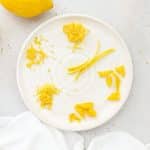Description
Learn how to zest a lemon 5 ways to add a lovely lemon twist to your next recipe!
Ingredients
- Fresh lemons
- A microplane zester, box grater, handheld zester with channel knife, sharp knife, or vegetable peeler
Instructions
With A Microplane Zester/Rasp Grater:
- Hold the microplane zester in one hand and your lemon in the other. For added stability, I recommend bracing either the zester or the lemon on a stable surface like a countertop or cutting board.
- Scrape the lemon across the surface of the microplane zester (or the zester across the surface of the lemon), rotating the lemon as you go. (Move to the next section as soon as you see white. You want ONLY the yellow lemon zest, NOT the white pith). If any zest sticks to the back side of the zester, gently tap it off or use a knife to scrape it away. Watch out for sharp edges!
With A Box Grater:
- Hold the box grater in your non-dominant hand and your lemon in your dominant hand.
- Scrape the lemon across the smallest side of the box grater, rotating the lemon as you go. (Move to the next section as soon as you see white. You want ONLY the yellow lemon zest, NOT the white pith).
With A Handheld Zester Tool (Or A Channel Knife):
- The small, circles at the top of this tool are the zester, while the indented grater on the side is called the channel knife. The zester will form long strings of zest, while a channel knife will make large sections of peel.
- To use the zester end, hold the tool in your dominant hand and gently press the zester down into the lemon zest and scrape towards your body, doing your best to remove just the yellow zest.
- To use the channel knife, hold the zester tool in your dominant hand. Press in and scrape to make long strips of zest.
With A Knife:
- Carefully use a small, sharp knife (like a paring knife or serrated paring knife) to cut away the zest in large sections, trying your best to avoid the white pith.
- From there, you can use the large pieces, or you can mince or slice the strips of zest into smaller pieces, as needed/desired.
With A Vegetable Peeler:
- If you have a very sharp vegetable peeler and a firm lemon, you can use it like a paring knife, to carefully remove the zest in long strips. Again, aim to only remove the yellow peel, not the white pith.
Notes
Tips:
- Lemon zest is the yellow peel ONLY. Avoid the spongy white pith underneath the zest, which is bitter.
- 1 medium lemon = 1 Tablespoon of lemon zest
- lemon zest is best used immediately, but can be frozen up to 1 month.
- To remove wax from lemons, place them in a colander and pour very hot (boiling) water over them to dissolve the wax, then scrub with a microfiber cloth or vegetable brush and rinse again.
- Zest FIRST. If you’re juicing AND zesting a lemon, make sure to zest the lemon first. It’s easier and more effective when the lemon is whole.
- Prep Time: 5 minutes
- Category: Tutorial
- Method: No-Cook
- Cuisine: American

